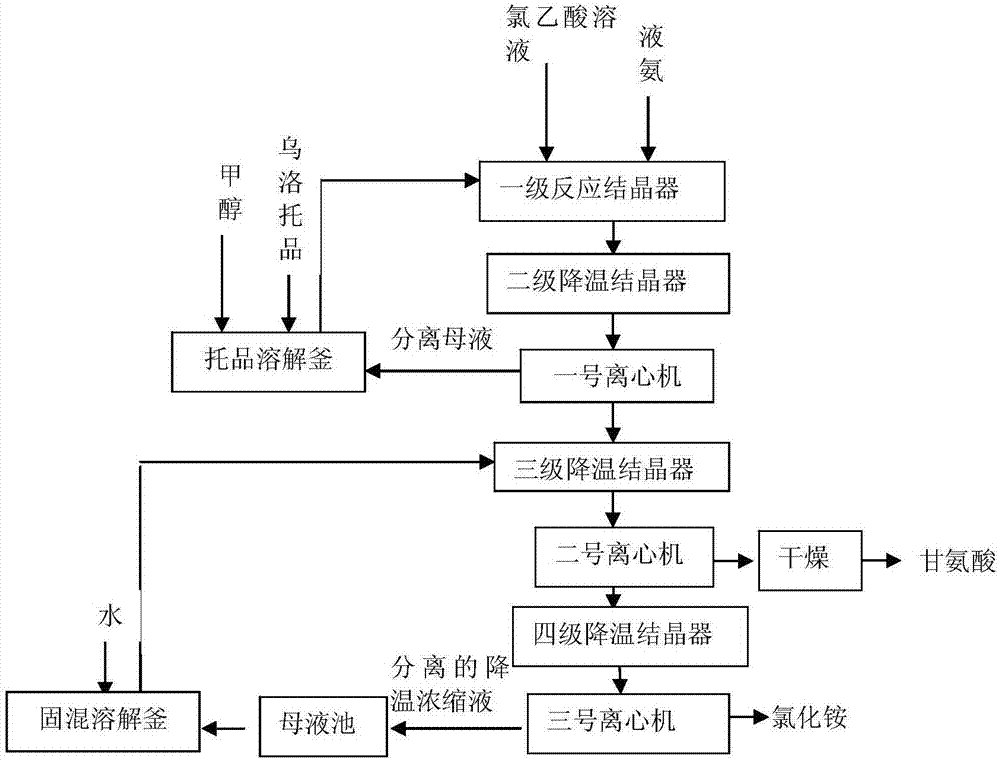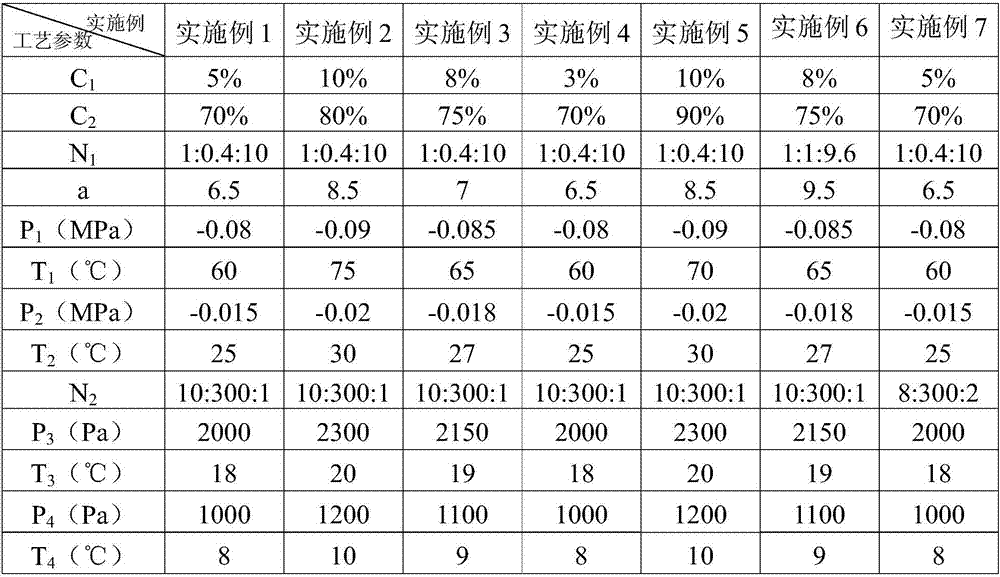Process for producing glycine byproduct ammonium chloride
A production process, the technology of ammonium chloride, is applied in the production process field of co-production of ethyl ammonium chloride with glycine, which can solve the problems that the catalyst urotropine cannot be recycled, cannot handle the residual liquid, and affects the cooling of the system, so as to achieve no residue Liquid production, reduced methanol usage, and low equipment investment
Active Publication Date: 2017-08-25
闫小玉 +1
View PDF3 Cites 9 Cited by
- Summary
- Abstract
- Description
- Claims
- Application Information
AI Technical Summary
Problems solved by technology
[0003] The prior art mainly has the following defects: 1. the prior art is a batch reaction, and the investment in equipment is large, the labor intensity is high, and the production efficiency is low
②The alcohol analysis process will use a large amount of methanol, and methanol recovery requires a lot of energy consumption
③ Catalyst urotropine cannot be recycled, resulting in waste of raw materials
④ The existing process will produce a large amount of residual liquid that cannot be handled
⑤A large amount of wall sticking phenomenon will appear on the contact surface of alcohol phase reaction cooling, which seriously affects the cooling of the system
Method used
the structure of the environmentally friendly knitted fabric provided by the present invention; figure 2 Flow chart of the yarn wrapping machine for environmentally friendly knitted fabrics and storage devices; image 3 Is the parameter map of the yarn covering machine
View moreImage
Smart Image Click on the blue labels to locate them in the text.
Smart ImageViewing Examples
Examples
Experimental program
Comparison scheme
Effect test
Embodiment 1-12
[0035] According to the production process of the above glycine by-product ammonium chloride, process parameters are as shown in Table 1 and Table 2 below:
[0036] Table 1 process parameter table
[0037]
[0038] Table 2 Effect of crystallization temperature and pressure
[0039]
[0040]
the structure of the environmentally friendly knitted fabric provided by the present invention; figure 2 Flow chart of the yarn wrapping machine for environmentally friendly knitted fabrics and storage devices; image 3 Is the parameter map of the yarn covering machine
Login to View More PUM
 Login to View More
Login to View More Abstract
The invention provides a process for producing glycine byproduct ammonium chloride. The process comprises the following steps: by taking a chloroacetic acid solution as a raw material, carrying out an ammonolysis reaction with ammonia through catalysis of urotropine; performing negative pressure condensation on the reaction solution, cooling and crystallizing to obtain a mixture of glycine and ammonium chloride; and performing gradient cooling on the mixture so as to obtain glycine and high-purity ammonium chloride, and recycling the mother solution. According to the process disclosed by the invention, continuous production of glycine is realized, the production efficiency is improved, the labor intensity is reduced, the equipment input is reduced, and the catalyst, urotropine, can be recycled in the reaction by adopting the recycling process for the alcohol-phase reactive mother solution. Moreover, the ammonium chloride is separated by adopting the concentrating, cooling and crystallizing process, the usage amount of methanol is reduced, the energy consumption is reduced, and residual liquor is avoided.
Description
technical field [0001] The invention belongs to the technical field of chemical production and relates to a production process for co-producing ethyl ammonium chloride from glycine. Background technique [0002] Glycine is an important raw material for products such as glyphosate and glycine ethyl ester hydrochloride, and it can also be refined into food-grade glycine for use. The existing glycine production technology is to produce a mixture of glycine and ammonium chloride through catalyzed ammonium decomposition of chloroacetic acid in the water phase. The mixture solution is separated by methanol alcohol analysis to obtain the finished product of glycine, and the separated mother liquor is obtained by rectification to obtain 92% The methanol is continued to be used for alcohol analysis, and the rectification raffinate is distilled to obtain industrial grade ammonium chloride. [0003] The prior art mainly has the following defects: 1. the prior art is a batch reaction, ...
Claims
the structure of the environmentally friendly knitted fabric provided by the present invention; figure 2 Flow chart of the yarn wrapping machine for environmentally friendly knitted fabrics and storage devices; image 3 Is the parameter map of the yarn covering machine
Login to View More Application Information
Patent Timeline
 Login to View More
Login to View More Patent Type & Authority Applications(China)
IPC IPC(8): C07C227/08C07C227/40C07C227/42C07C229/08C01C1/16
CPCY02P20/584C07C227/08C01C1/164C07B2200/13C07C227/40C07C227/42C07C229/08
Inventor 闫小玉
Owner 闫小玉
Features
- R&D
- Intellectual Property
- Life Sciences
- Materials
- Tech Scout
Why Patsnap Eureka
- Unparalleled Data Quality
- Higher Quality Content
- 60% Fewer Hallucinations
Social media
Patsnap Eureka Blog
Learn More Browse by: Latest US Patents, China's latest patents, Technical Efficacy Thesaurus, Application Domain, Technology Topic, Popular Technical Reports.
© 2025 PatSnap. All rights reserved.Legal|Privacy policy|Modern Slavery Act Transparency Statement|Sitemap|About US| Contact US: help@patsnap.com



